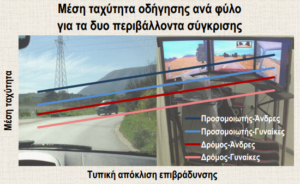
This Diploma Thesis aims to compare the behavior of young drivers in normal and simulated driving conditions. In order to achieve this objective, data were collected through an experimental process on a driving simulator but also in a real car, in which all the participants drove in different driving scenarios at an interurban road. Lognormal regression methods were developed for the identification of the impact of driving environment (simulated and real road conditions), basic driver characteristics (mileage, age, gender), as well as the driving style (average acceleration, deceleration and standard deviations of them) to the average vehicle speed change. Through model implementation, it was revealed that absolute values of drivers’ traffic performance varies between simulated and real driving conditions. On the contrary, relative differences of driver behaviour at the two driving environments remain mostly the same. More precisely, speed difference between fast and slow drivers is the same at the two driving environments, as is also speed difference the same at the two driving environments between drivers talking and not talking to the co-driver.
| ID | ad47 |
| Presentation | |
| Full Text | |
| Tags | driver behaviour, driving simulator, naturalistic driving, statistical modelling, young drivers |













